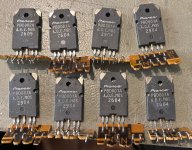I stumbled on this obsolete Pioneer Elite receiver, and fell on my behind looking at the schematics: I never thought Pioneer would build a 7-channel all FETs power amplifier in a receiver. In any case, I am turning it into a stereo amplifier. And given the RDS of output devices, I would like to put to use the unused MOSFETs of the other channels. This is my shot at how it could be done: The X means the line is cut, the lines are a new junction.

This from another thread: "The MOSFETs look to be made by Sanken and re-badged for Pioneer. The Sanken original parts are SAPM01N and SAPM01P - a kind of 'ThermalTrak' FET with temperature compensation built-in."
I have little experience at this, and seeking advice. Anything I should worry about?
FYI This is what's upstream: (to be connected to the left of the above) This also is all fets.

This from another thread: "The MOSFETs look to be made by Sanken and re-badged for Pioneer. The Sanken original parts are SAPM01N and SAPM01P - a kind of 'ThermalTrak' FET with temperature compensation built-in."
I have little experience at this, and seeking advice. Anything I should worry about?
FYI This is what's upstream: (to be connected to the left of the above) This also is all fets.
Last edited:
This is an update and conclusion of the all-mosfet-amp coming out of the 20-year old obsolete receiver closet.
The amp is based on the Cirrus Logic "High Voltage Power Operational Amplifiers":

Which, together with the output stage above, makes it fully fet/mosfet from input to output.
Of course, all the quality this may bring is all wasted with the IC processors/op amps orgy of the preamp section.
So I gutted out everythig not related to the power amp. I also found the reason why the amp was broken: R4206 and R4207 are 100 ohms resistors between the power supply and the op-amps. They are surface-mounted, and could not dissipate the power generated by the op-amps consumption. One of the resistors failed and measured at around 800 ohms, unbalancing the op-amp power resulting in DC at the output, and the protection kicking in.
Speaking of protection, the original protection mecanism was computer-monitored, so I had to replace it with a chinese protection module, which works pretty well:

R4206 and R4207 are now new 1/4W. Now as to the title of my post, I did successfuly paralleled output MOSFETs from 2 other channels (remember this is a 7.1 amp) as per my drawing above. So the amp now has double the outputs it had.

The amp is based on the Cirrus Logic "High Voltage Power Operational Amplifiers":
Which, together with the output stage above, makes it fully fet/mosfet from input to output.
Of course, all the quality this may bring is all wasted with the IC processors/op amps orgy of the preamp section.
So I gutted out everythig not related to the power amp. I also found the reason why the amp was broken: R4206 and R4207 are 100 ohms resistors between the power supply and the op-amps. They are surface-mounted, and could not dissipate the power generated by the op-amps consumption. One of the resistors failed and measured at around 800 ohms, unbalancing the op-amp power resulting in DC at the output, and the protection kicking in.
Speaking of protection, the original protection mecanism was computer-monitored, so I had to replace it with a chinese protection module, which works pretty well:
R4206 and R4207 are now new 1/4W. Now as to the title of my post, I did successfuly paralleled output MOSFETs from 2 other channels (remember this is a 7.1 amp) as per my drawing above. So the amp now has double the outputs it had.
